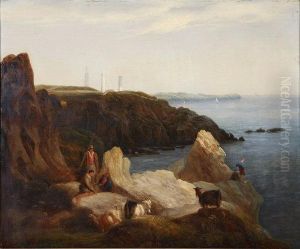George Mounsey Atkinson Paintings
George Mounsey Wheatley Atkinson, born in 1806, was an Anglo-Irish artist known for his maritime and shipping scenes. Although not as widely recognized as some of his contemporaries, Atkinson's work provides a valuable glimpse into the nautical life and vessel design of the 19th century. His penchant for detail and accuracy in his depictions of ships has made his paintings a useful resource for historians and enthusiasts of maritime history.
Atkinson was born in Cork, Ireland, and his middle name, Wheatley, suggests he may have been related to the Wheatley family, who were also artists. Little is known about Atkinson's early life or where he received his artistic training. However, his career progressed in Ireland, where he became known for his skill in capturing the dynamic energy of the sea and the intricacies of ship construction.
The majority of Atkinson's works were created between the 1830s and the 1870s, a period that saw significant changes in the design and technology of ships, transitioning from sail to steam power. Atkinson documented these changes in his paintings, which often featured both military and commercial vessels. His attention to detail not only made his work aesthetically pleasing but also historically significant, as it recorded the evolution of shipbuilding over several decades.
Atkinson's paintings were primarily executed in oils, and he was particularly adept at rendering the effects of light and atmosphere, characteristics that enhanced the realism of his maritime scenes. Despite his focus on ships and the sea, he occasionally painted landscapes and coastal scenes without vessels, although these works are less known.
George Mounsey Wheatley Atkinson died in 1884, having left behind a body of work that continues to be appreciated by maritime art collectors and historians. While he may not have achieved the fame of some of his peers, his paintings remain a testament to the rich maritime heritage of his era and the artistic skill required to depict it.


